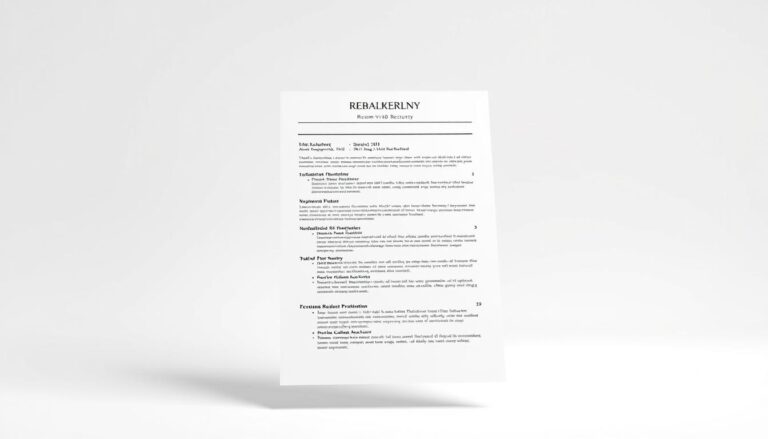Tips for Writing a Strong Professional Bio

In today’s digital world, a professional bio is key to your online image. It’s a quick overview of your work experience, skills, and achievements. It’s vital for gaining trust and credibility.
A well-written bio can make you shine and show off your skills. To do this, use writing tips that focus on your strengths. This way, you’ll create a strong bio that people remember.
With the right approach, your professional bio can open doors to new chances.
The Importance of a Well-Crafted Professional Bio
Your professional bio is often the first thing people see online. It’s key to making a good first impression in the digital world. A well-written bio helps you stand out and shows you’re an expert in your field.
A good bio should be concise, informative, and engaging. It gives readers a quick look at your experience and skills. Writing a great bio boosts your online presence and helps build your personal brand.
A well-crafted bio can also open doors to new opportunities. This could be a new job, a speaking gig, or a business partnership. It’s a vital tool for anyone wanting to grow their career and network.
In short, a well-crafted professional bio is essential for a strong online presence. Focus on being clear, concise, and engaging. This way, your bio will effectively show your professional worth.
Understanding Your Target Audience
Before you start writing your professional bio, it’s key to know who you’re writing for. Knowing your audience helps you make your bio fit their needs and interests.
Your bio will be read by various groups, each with their own expectations. Understanding these groups is crucial to making a bio that hits the mark.
Potential Employers and Recruiters
Potential employers and recruiters are a big part of your audience. They look for your skills, experience, and achievements. Your bio should show off your professional strengths and career goals.
Clients and Customers
If you’re a freelancer or business owner, clients and customers will read your bio. They want to know what you offer and how you can help them. Make sure your bio clearly states your services and what makes you unique.
Industry Peers and Collaborators
Your bio will also reach industry peers and potential collaborators. They’re interested in your expertise and how you can work together. Show your achievements and collaborations to grow your professional network.
By knowing your audience, you can write a professional bio that clearly shows your value. It will resonate with your readers.
Essential Elements of a Professional Bio
A successful professional bio shows off your achievements and experience. It includes your name, job, and background. But to really stand out, you need to add key elements that show your skills.
Quantifying Your Achievements
One key part is to show your achievements with numbers. Instead of saying “increased sales,” say “increased sales by 25% within 6 months.” This shows how much you’ve done and how well you’ve done it.
Using numbers helps others see the value you bring. It’s about being clear and showing proof of your skills and success.
Highlighting Career Milestones
Another important thing is to talk about your career highlights. This includes big roles, awards, or projects you’ve led. These show how far you’ve come and how skilled you are.
For example, you could say you “led a team to successfully launch a product that became a top seller” or “received an award for outstanding performance in your field.” These statements not only show your achievements but also tell your professional story.

By adding these key elements—showing your achievements with numbers and talking about your career milestones—you can make a bio that’s both interesting and informative. The goal is to show your skills and experience in a way that connects with your audience.
Tips for Writing a Strong Professional Bio: The Process
Creating a strong professional bio is all about strategy. It’s about showing off your professional brand in the best way. To do this, you need to know the steps to make your bio stand out.
Reviewing Successful Bios in Your Industry
Start by looking at successful bios in your field. See what makes them good, like their structure and tone. This will help you understand what your audience likes.
In the tech world, for example, successful bios often talk about new tech or innovations. Use this to make your bio fit your industry’s style.
Identifying Your Unique Value Proposition
Finding your unique value proposition (UVP) is key to standing out. Your UVP should be clear in your bio, showing what you offer that others don’t.
Think about your skills, achievements, and experiences. What are you known for? What value do you bring to your clients or team? By focusing on your UVP, your bio will show your professional side and your impact.
By using these tips for writing a strong bio, you can tell a compelling story. This story will capture your professional essence and connect with your audience. Remember, your bio is a work in progress. Keep making it better to stay relevant and impactful.
Crafting Bios of Different Lengths
The length of your professional bio matters a lot. It affects how well you share your skills with others. Being able to write bios of various lengths is key. It lets you tailor your message for different places and people.
A Twitter bio might be short, mentioning your job and what makes you special in 280 characters. But a bio on your website or LinkedIn can be longer. It can share more about your experience, achievements, and what you offer to your field.
Key Considerations for Different Bio Lengths include knowing the platform’s limits and what your audience likes. Social media bios need to be short and catchy. But a website bio can be more detailed, showing your career path and skills.
For longer bios, talk about your big wins, your career, and important projects. Shorter bios should focus on what makes you unique and your main strengths.
Learning to write bios of different lengths helps make your bio always fit, no matter where it’s seen.
Language and Style Best Practices
Your professional bio needs to use language and style that connects with your readers. How you present yourself can greatly affect how others see you and your professional image.
When writing your bio, think about industry-specific language considerations. Using terms from your field shows you know your stuff. But, don’t use jargon that might confuse or push people away.
Industry-Specific Language Considerations
Adapting your language to your industry doesn’t mean using hard terms. It’s about knowing the details of your field and talking in a way that’s both professional and easy to understand. For example, a medical bio might use specific medical terms, while a tech bio might talk about the latest tech.

While it’s important to use industry-specific language, keeping your voice authentic is just as key. Your bio should show who you are and what you do. Don’t try to sound like someone else or use a tone that doesn’t feel right.
By mixing industry-specific terms with your true voice, you can make a bio that grabs attention and works well. This mix is essential for leaving a good and lasting impression on your readers.
Industry-Specific Bio Examples
Looking at industry-specific bio examples can help you understand what works best in your field. You’ll see how different industries use structure, tone, and content in their bios. This knowledge is crucial for creating a bio that speaks to your audience.
In the tech world, bios are often short and highlight technical skills. Creative fields, on the other hand, prefer longer bios that tell stories of creative work. Knowing these differences is essential for making a bio that connects with your audience.
For example, in healthcare, bios focus on credentials and patient care. A doctor’s bio might list their medical school and specialty areas. In finance, bios highlight achievements like successful investments and leadership roles.
Studying industry-specific bio examples can also show you what to avoid. Avoiding technical terms that might confuse people is key. By learning from others, you can craft a bio that clearly shows your professional brand.
Key takeaways include the importance of relevance, clarity, and a consistent tone. Using these elements, you can make a bio that showcases your skills and appeals to your audience.
Common Mistakes to Avoid in Professional Bios
Writing a professional bio requires avoiding mistakes that can harm your image. A well-written bio is key to making a good first impression.
One big mistake is using jargon or technical terms that might confuse people. It’s important to speak clearly and simply. This way, you can share your professional brand effectively.
Being too vague or generic is another error to avoid. Your professional bio should show what makes you different. If you don’t, your bio might not stand out.
To write a great bio, focus on your achievements and the value you offer. Stay away from clichés and phrases that don’t add anything meaningful.
By avoiding these common mistakes, you can create a professional bio that grabs attention and is both informative and memorable. This will help you build a strong professional image and leave a lasting impression.
Conclusion
A well-crafted professional bio is key to making a good first impression online. By following the tips in this article, you can highlight your expertise. This helps establish your authority in your field.
Customizing your bio for your audience and using the right industry terms boosts your online presence. It’s also important to avoid common mistakes to build a strong personal brand.
With a professional bio that clearly shows your value, you can draw in new opportunities. This can help you move forward in your career. By using the advice given, you can leave a lasting impression and reach your professional goals.






